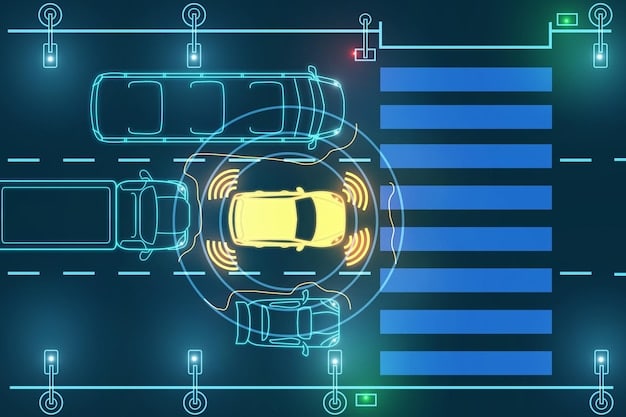Decoding Level 3 Autonomous Driving: A Guide for US Drivers

Decoding Autonomous Driving Levels: What Does Level 3 Really Mean for US Drivers? Level 3 automation marks a critical step where vehicles can perform driving tasks under certain conditions, requiring human intervention when prompted, impacting safety and regulation for drivers in the US.
The concept of autonomous driving has rapidly evolved, and understanding the various levels of automation is key to navigating this technological frontier. Decoding Autonomous Driving Levels: What Does Level 3 Really Mean for US Drivers? is crucial as it represents a significant leap towards vehicles handling more driving tasks, but with the understanding that human intervention is still necessary.
Understanding the Levels of Autonomous Driving
Autonomous driving isn’t an all-or-nothing proposition. It’s a spectrum, and to really understand what Level 3 means, we need to quickly review all the levels as defined by SAE International. These levels range from 0 (no automation) to 5 (full automation).
Each level represents a different stage in the development of self-driving technology, with increasing levels of autonomy and decreasing reliance on human drivers. Understanding these distinctions is vital for consumers, regulators, and manufacturers alike.
SAE Levels Explained
The Society of Automotive Engineers (SAE) has defined six levels of driving automation, which have become the standard for classifying autonomous vehicles. Let’s break them down:
- Level 0: No Automation: The driver is in complete control, performing all driving tasks.
- Level 1: Driver Assistance: The vehicle offers assistance with a single task, like cruise control or lane keeping assistance.
- Level 2: Partial Automation: The vehicle can control both steering and acceleration/deceleration under certain circumstances, but the driver must remain attentive and ready to take control.
- Level 3: Conditional Automation: The vehicle can perform all driving tasks in specific conditions. However, the driver must be ready to intervene when prompted.
- Level 4: High Automation: The vehicle is capable of performing all driving tasks in specific conditions and will safely stop if the driver doesn’t respond to a request to intervene.
- Level 5: Full Automation: The vehicle can perform all driving tasks in all conditions. No human intervention is ever required.
These levels are important because they set the bar for consumers. Understanding the levels helps everyone be on the same page about how the technology works.
What Defines Level 3 Autonomous Driving?
Level 3 is perhaps the most intriguing and complex level because it’s the first point where the vehicle truly takes over “driving” tasks. What does that mean for the driver?
It means the system is capable of monitoring the driving environment and operating the vehicle without driver input under specific conditions. However, it doesn’t mean you can take a nap behind the wheel.

Key Features of Level 3
What exactly sets Level 3 apart from the others? Here are the key features that define this level of automation:
- Conditional Automation: The vehicle handles all aspects of driving in specific environments (e.g., highways with clear lane markings and no pedestrians).
- Environmental Monitoring: The vehicle uses sensors like cameras, radar, and lidar to perceive its surroundings.
- Driver Attention Required: The driver must be ready to intervene when the system requests.
- Fallback Performance: The system must be able to safely transfer control back to the driver in case of system failure or when conditions exceed the system’s capabilities.
One of the biggest advancements within Level 3 is the sensor technology. The vehicle should always know the conditions around it to drive safest.
In summary, Level 3 is a big step forward, but it comes with responsibilities. Drivers have to pay attention and be ready to take over when prompted. It’s not quite the hands-off experience many people imagine when they think of self-driving cars.
The Technological Underpinnings of Level 3
Level 3 autonomy relies on sophisticated technology to perceive the world, make decisions, and control the vehicle. Let’s peek under the hood and see what makes it tick.
The goal is to replicate and even exceed human perception and reaction times. This requires a combination of advanced sensors, powerful processors, and intricate software algorithms.
Key Technologies
These technologies are crucial as cars become smarter and more aware:
- Sensor Suite: Radar, lidar, cameras, and ultrasonic sensors work together to create a comprehensive understanding of the vehicle’s surroundings.
- High-Performance Computing: Powerful processors are needed to crunch the vast amounts of data generated by the sensors in real-time.
- Artificial Intelligence (AI): AI algorithms, particularly machine learning, are used to interpret sensor data, predict the behavior of other road users, and make driving decisions.
- Redundant Systems: Backup systems are essential to ensure safety in case of component failure.
All of these technologies have to work together in seamless ways. Otherwise, the Level 3 vehicle may become dangerous.
In short, Level 3 is only possible due to a combination of cutting-edge technologies working in harmony. These systems are still evolving, and as they improve, we can expect Level 3 systems to become more capable and reliable.

The Legal and Regulatory Landscape in the US
The introduction of Level 3 autonomous driving raises complex legal and regulatory questions. Who is responsible when an accident occurs? How should these systems be tested and certified?
Because this technology is so new, this is a gray area. The specific laws and regulations surrounding autonomous vehicles vary from state to state, creating a patchwork of rules across the country.
Challenges and Considerations
As more autonomous vehicles hit American roads, regulators and lawmakers will need to address a range of key considerations:
- Liability: Determining who is responsible in the event of an accident when the vehicle is in autonomous mode.
- Testing and Certification: Establishing standardized testing procedures and certification requirements for Level 3 systems.
- Data Privacy: Addressing concerns about the collection, storage, and use of data generated by autonomous vehicles.
- Cybersecurity: Protecting autonomous vehicles from hacking and other cybersecurity threats.
There are also potential federal regulations needed. The question remains, how can the federal government help standardize these new regulations?
To summarize, the legal and regulatory landscape for Level 3 autonomous driving in the US is still evolving. As the technology matures and becomes more widespread, we can expect to see increased legislative and regulatory activity at both the state and federal levels.
The User Experience: What to Expect in a Level 3 Car
For drivers, the experience of using a Level 3 car can be quite different from driving a traditional vehicle. While the car can handle many driving tasks, it’s not a completely hands-off experience.
One of the biggest changes is also the responsibility of paying attention. The driver has to be ready to take over when asked.
What’s it like to drive?
In the future, the user experience will become more streamlined. However, for now, you’ll likely notice these features:
- Limited Operational Design Domain (ODD): The system will only operate in specific conditions, such as well-marked highways at speeds below a certain threshold.
- Takeover Requests: The system will alert the driver when it needs them to take control, providing a certain amount of lead time.
- Engagement and Disengagement: Learning how to smoothly transition between autonomous and manual driving is key to a positive experience.
Level 3 cars must clearly display when they are on and when they need help from a driver. This clarity helps drivers ease their stress.
Ultimately, driving a Level 3 car requires a shift in mindset. It’s not about completely relinquishing control, but rather about sharing the driving task with the vehicle. Clear communication and a smooth handover process are essential for a safe and enjoyable experience.
Challenges and Limitations of Level 3 Technology
Despite its potential, Level 3 technology faces significant challenges and limitations that must be addressed before it can be widely adopted.
One big thing to think about is the driver’s attention. Can a driver really maintain attention after not doing anything behind the wheel for hours?
Key Obstacles
Level 3 technology has some challenges to overcome:
- Driver Attention: Ensuring that drivers remain alert and ready to take control when needed.
- Weather Conditions: The performance of sensors can be degraded by adverse weather conditions such as rain, snow, and fog.
- Complex Scenarios: Handling complex or unexpected driving scenarios that the system hasn’t been trained for.
The reality is, the world is unpredictable. A tree can fall down in the middle of the road. Construction can cause traffic jams. Level 3 vehicles have to be prepared.
In conclusion, Level 3 autonomous driving holds great promise, but it’s not without its challenges. As the technology matures and these limitations are addressed, we can expect to see more widespread adoption of Level 3 systems in the years to come.
| Key Point | Brief Description |
|---|---|
| 🚗 Level 3 Definition | Conditional automation; vehicle drives in specific conditions, requires driver intervention. |
| 🚦 Legal Challenges | US regulations vary by state; liability in accidents is a key concern. |
| 👨 driver Attention | Drivers must be alert and ready to take control when the system prompts. |
| 🌦️ Weather Limitations | Adverse weather impacts sensor performance, limiting Level 3 capabilities. |
FAQ
▼
Conditional automation means the vehicle can handle all driving tasks under specific circumstances, like highway driving with clearly marked lanes and good weather. Outside these conditions, the driver must take over.
▼
Level 3 technology is just starting to become available in select models in the US. Availability varies by manufacturer and region, so it’s best to check with specific automakers for the latest information.
▼
If the driver doesn’t respond to a takeover request, the vehicle is designed to perform a safe, controlled stop. The car will attempt to minimize risks to itself and other road users during the process.
▼
Level 3 cars will likely request driver intervention in complex situations like active construction zones. The sensors and software may not be able to reliably navigate these dynamic and unpredictable environments autonomously.
▼
It is too early to tell with any certainty. Some experts believe Level 3 technology will ultimately lower insurance premiums. However, other experts believe the impact is uncertain. It may depend on accident data during these new advances.
Conclusion
Decoding Autonomous Driving Levels: What Does Level 3 Really Mean for US Drivers? In conclusion, Level 3 autonomous driving represents a significant, yet complex, step towards self-driving cars, offering conditional automation that requires attentive human oversight, and as US drivers navigate this evolving technology, understanding its capabilities, limitations, and the surrounding legal landscape is essential for safe and responsible adoption.





